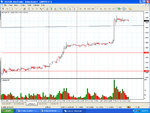firewalker99
Legendary member
- Messages
- 6,655
- Likes
- 613
Charlton said:FW
It's not easy to take volume into account as well. When you combine price and volume analysis you clearly increase the number of combinations of analytical "patterns" (please note patterns is used loosely). In additon the combinations have to (have to here meaning in the context of what I am talking about rather than infering that there is any obligation for the reader to do this) be looked at in the context of other parts of the chart.
Clearly you have made a success without using volume and without using all the attributes of a bar. Later you may or may not decide to examine these - that is up to you. In a thread entitled Price and Volume if I discuss what is "required" then it is in the context of that thread. This is no different to me posting in an indicators thread (I do not use them myself) and saying that this is the way that the RSI should be used. It doesn't mean that you and I must use them. It merely means that if you happen to choose to use RSI then this is the way to use it.
I will end this message with one final thought - why is volume data difficult to obtain in some situations. Why do you have to pay for Level II, when level 1 is generally free. There are certain datasets that professionals prefer you do not see. Why ?
Charlton
I agree that volume probably holds a key to unlocking the predictive potential of your strategy. And I hope to incorporate it too one time, as I'm already learning to read it more efficiently by knowing WHEN and WHERE to read it, instead of looking at too many separate single bars for a clue.
I'm sure there are several signals that can be confirmed by the way a bar has formed, like a strong hammer on support can be a buy sign for some people. And all of this might come into play when I'm at a further stage of refining and going through some retesting... but as you're aware of where I came from, I don't want to rush into things. I'm reasonable happy with what I have now and confident in it. It's far from perfect, and those who manage to take in account all the signals a market gives in any which way that is will surely benefit of it.
Perhaps in the near future I will frequent this thread more often and haunt you with questions 😉

